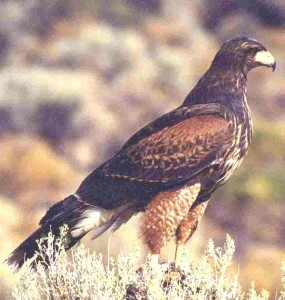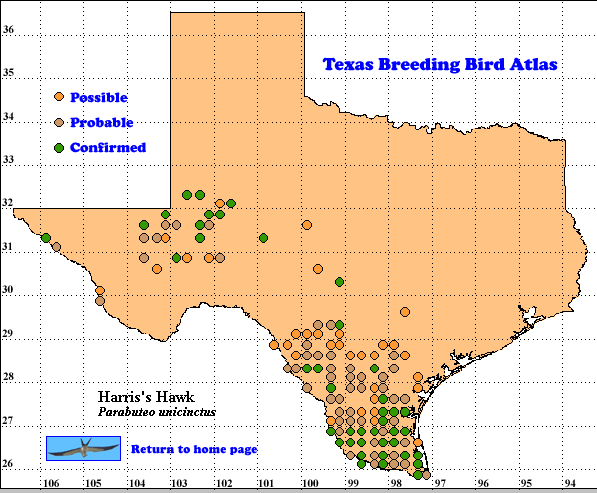The behavior of Harris’s Hawk has been extensively investigated in recent decades by ornithologists intrigued by reports in Bent (1937) of Harris’s Hawks hunting in groups. These family groups chase prey as large as hares, taking turns running their quarry to exhaustion. Alternatively if the prey hides under a bush, one hawk flushes the prey while the others wait in a circle to pounce on it as it emerges. The groups shares the kill as a wolf pack does. Arizona pairs most often have helpers while the phenomena is rarer in Texas (Bednarz 1995).
DISTRIBUTION. During the 1987-1992 field work seasons of the TBBA project, observers found most breeding sites in the South Texas Brush Country, Coastal Sand Plain and southern Coastal Prairies regions (see the region map in Lockwood and Freeman [2004]). More widely scattered sites were found in the southern High Plains, Trans-Pecos and Edwards Plateau regions. Breeding Bird Survey (BBS) data show relative abundances of 3-10 hawks per 40 km (25 mi) route in western South Texas Brush Country, decreasing from there to <1 in most of the rest of the area described above (Sauer et al. 2007). The three highest BBS route averages for this species (6.3, 5.3 and 4.0) were obtained in Zapata and Webb counties (Price et al. 1995).
Harris’s Hawks are also resident in much of south and central Arizona, southern New Mexico, most of Baja California and the northern mainland of Mexico and along or near the southwest coast of Mexico and the south coasts of Guatemala and El Salvador. This hawk is also distributed spottily from here to southern South America (Bednarz 1995, Howell and Webb 1995, Am. Ornithol. Union 1995, Corman 2005, Sauer et al. 2007).
SEASONAL OCCURRENCE. Harris’s Hawks are year-round residents throughout their range. The breeding season extends from January to September and occasionally November, based on egg dates from March 8 to November 13 and large young in a nest as early as February 17 (Oberholser 1974). Later studies in Texas show most first broods hatch in late April-May and fledge in June. When prey abundance is high, pairs attempt second and even third clutches with an interval of about 75 days between the starts of successive broods. Females may start laying the next clutch before the previous brood fledges (Brannon 1980, Bednarz 1995). Thus in years of good prey abundance, including tme for newly adult birds to form pairs and build nests, breeding activity may be observed in Texas in any month of the year.
BREEDING HABITAT. In Texas Harris’s Hawks are found from sea level to 850 m (2800 ft) primarily in mesquite woodlands with a prickly pear understory. Numbers of hawks are far fewer in the yucca-cactus-creosote bush habitat of the Trans-Pecos region. A few members of this species are found in juniper-oak habitat on the Edwards Plateau (Oberholser 1974). Other plants of the South Texas habitat include blackbrush, cenizo and guaijllo (Bednarz 1995). The species of plant selected for the nest site depends on the habitat, in Texas species used include mesquite, hackberry, live oak and large yuccas (Griffin 1976, Brannon 1980).
The nest is a shallow, elliptical saucer. South Texas dimensions average 46.6 cm (19 in) outside diameter, 23.3 cm (9 in) height, 23.8 cm (10 in) cup diameter and 5.3 cm (2 in) cup depth, but individual measurements vary considerably. This structure is built of dead or leafy twigs, assembled by the female. She usually lays 2-3 (range 1-5) white or very pale bluish eggs at 3-day intervals. Most of the 34-35 day incubation is done by the female; her mate and helpers relieve her at times, but mostly assist by feeding her. After hatching young birds spend about 45-47 days in the near and at least another 2 months with their parents (Griffin 1976, Bednarz 1995).
STATUS. Harris’s Hawk is common to uncommon in the South Texas Brush Country (Lockwood and Freeman 2004). This state holds most of the United States population of this hawk, 32 of the 41 BBS routes on which this hawk is detected are in Texas. Data from these routes suggests a slight annual population decline for the period 1980-2006 in both Texas and the southwest United States (Sauer et al. 2007). With the potential to expand its population rapidly and ability to adapt to the presence of humans, Harris’s Hawk may be as well suited as any hawk to survive future changes.
Text by Robert C. Tweit (2007)
Literature cited.
American Ornithologists’ Union. 1998. Checklist of North American birds, 7th ed. Am, Ornithol. Union, Washington, DC.
Bednarz, J. C. 1995. Harris’ Hawk (Parabuteo unicinctus). InThe Birds of North America, No. 146 (A. Poole and F. Gill, eds.). The Birds of North America, Inc., Philadelphia, PA.
Brannon, J. D. 1980. The reproductive ecology of a Texas Harris’ Hawk (Parabuteo unicinctus harrisi) population. Master’s thesis, University of Texas, Austin.
Corman, T. E. 2005. Harris’s Hawk (Parabuteo unicinctus). In Arizona Breeding Bird Atlas. pp. 140-141 (T. E. Corman and C. Wise-Gervais, eds.), University of New Mexico Press, Albuquerque.
Griffin, C. R. 1976. A preliminary comparison of Texas and Arizona Harris’ Hawks (Parabuteo unicinctus) populations. Raptor Res. 10: 50-54l
Howell, S. N. G. and S. Webb. 1995. A guide to the birds of Mexico and northern Central America. Oxford University Press, New York.
Lockwood, M. W. and B. Freeman. 2004. The TOS handbook of Texas birds. Texas A&M University Press, College Station.
Oberholser, H. C. 1974. The bird life of Texas, University of Texas Press, Austin.
Price, J., S. Droege, and A. Price. 1995. The summer atlas of North American birds. Academic Press, New York.
Sauer, J. R., J. E. Hines, and J. Fallon. 2007 The North American Breeding Bird Survey, results and analysis 1966-2006. Version 7.23.2007. USGS Patuxent Wildlife Research Center, Laurel MD < http://www.mbr-pwrc.usgs.gov/bbs>

